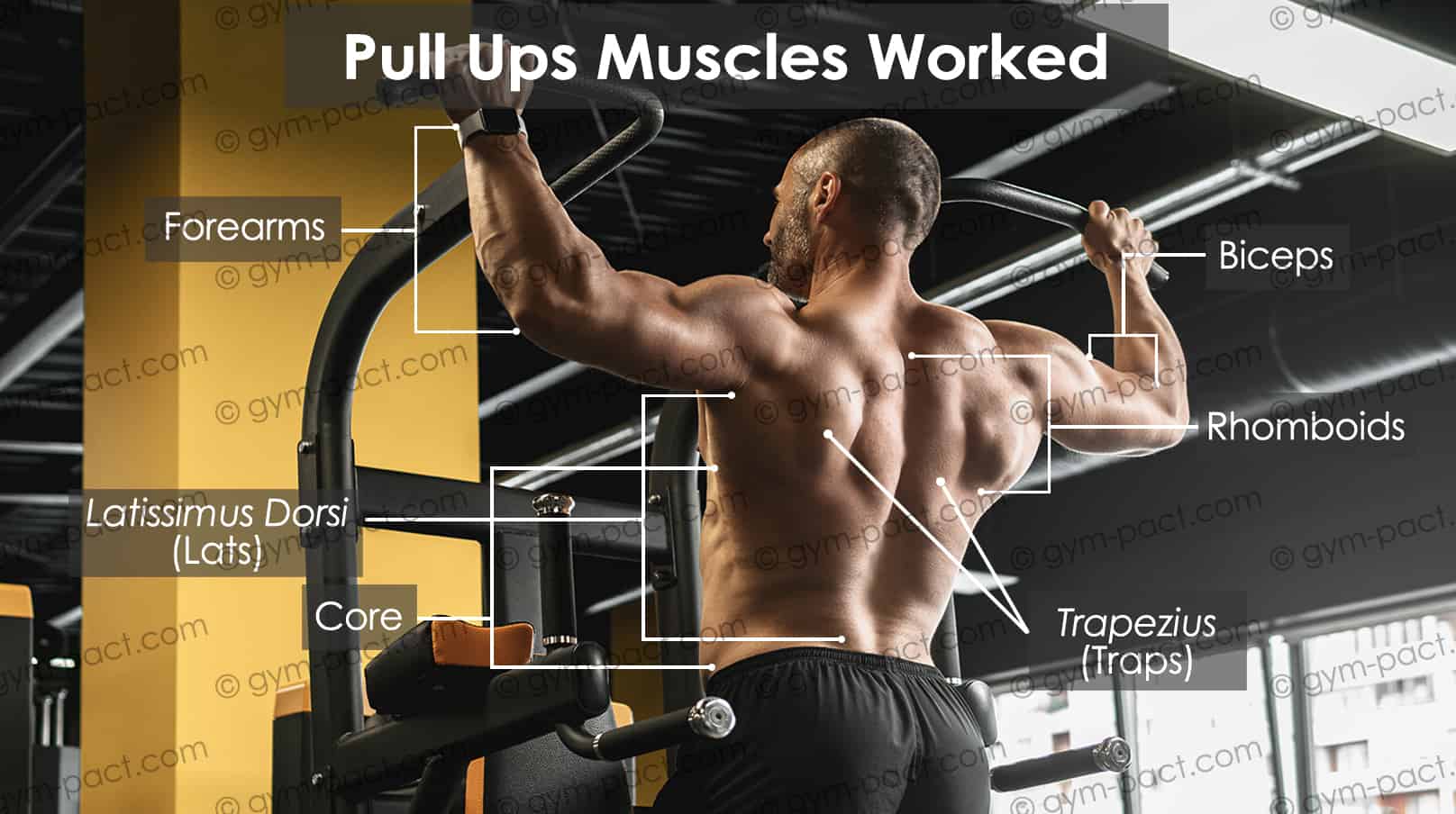I remember first getting into fitness as a skinny, weak kid and thinking “I can definitely do a pull-up, it’s so simple: just pull yourself up to the bar!”
I was very wrong.
After that, I hid away from them for years. I didn’t want to embarrass myself by failing in the middle of the gym.
I was too weak for them, and I thought I would never manage even 1 rep. I still knew pull-ups were the best upper back exercise. I needed to build a stronger upper back without this crucial movement – and these are the 10 best pull-up alternatives that helped me do it.
Whether you just want to get stronger building your first pull-up, these are the exercises you need…
What muscles does the pull-up train?
The challenge of finding a great pull-up alternative is that there are a lot of muscles to cover. This is why the pull-up is so popular – it works a variety of upper body muscles:

- The forearms
- The biceps
- Scapular retractors (like the rhomboids and traps)
- Scapular depressors (like the lats and trees)
- The muscles of the core/trunk
These muscles control the major movement skills of the pull-up. These are vertical pulling, horizontal pulling, grip, and trunk stability.
You might be noticing that these are most of the muscle groups in the upper body. It’s a bang-for-your-buck champion – so alternatives to pull-ups need to cover a lot of ground!
The 10 best pull-up alternatives You Can Do Anywhere
There’s a difference between not having access to a pull-up bar, and just lacking the necessary strength. Fortunately, today’s alternatives to the pull up are going to be useful in either situation.
I’ve split them into 3 categories:
- Bodyweight alternative exercises
- Weight training alternatives
- Assisted pull-ups (and component practice!)
This way, you can get great upper back work, whatever your limitation. These movements are all easier than normal pull-ups, too. You can find an alternative for your strength levels, no matter your experience.
Bodyweight back exercises
1. Inverted Rows
The bodyweight row is the best pull-up alternative for beginners.
The inverted row is a more horizontal pull than the pull-up, however. This places more focus on the arms, rhomboids, and lower trapezius muscles.
- Set up with a shoulder-width grip on a horizontal bar and your arms fully extended
- Keep your core tight and your body in a straight line from feet to head
- From the start position, pull yourself to the rings by pulling the shoulder blades back and flexing the biceps
- When you get to the end position, lower yourself back down slowly and under control
You can also perform ring rows in the exact same way. The ring row builds more grip and stabilizer strength using gymnastic rings.
You can make both of these bodyweight rows easier by moving your feet closer to the rings. You can also make them harder by moving your feet forward or elevating them.
Whatever your current strength, you can train with bodyweight rows.
2. Elevated-foot chin-ups
If you’ve got gymnastic rings, you can get all the benefits of a pull-up with the elevated-foot chin-up. This is an easier version of the chin-up where your legs take some of your weight.
This prioritizes the arms and trunk while developing the key movement skills you need for a pull-up or chin-up. It’s great for the physique, strength, and for getting better at pull-ups!
- Set up with your feet on an elevated surface – with a roughly 90-degree angle in the hip
- Take an underhand grip on the rings and lower yourself to arms’ length
- Keeping the core tight, pull yourself up to the rings by pulling the shoulder blades down and closing the elbow
- Hold the top position briefly before lowering yourself back down under control
3. Squatting rows
These are a classic bodyweight row– and there are tons of variations. The idea is simple: get into a squatting position and row your bodyweight.
You can perform this exercise with a towel, in a door-way, against a tree with a strong cable/rope, whatever. The point is simple: it’s easy to do and you can improvise this exercise nearly anywhere.
- Set your grip on a towel or doorway with your torso upright
- Bend your knees to roughly 90-degrees, without adjusting your upper body position
- Tuck your shoulders back, bending the arms, and pulling your chest towards the door/support
- Pause briefly at the end of your range and slowly lower yourself back to the start position
Door-frame variation:
This is a horizontal pull, so it’s more like a seated cable row than a pull-up. However, this is going to build a lot of the same back muscles without the difficulty or pull-up bar. This makes the door and towel row great alternatives to pull-ups for a home workout.
Weight training pull-up alternatives
4. Lat pulldowns
This machine exists for vertical pulling.
The pulldown is a classic choice for building the muscles of the upper back. It’s very similar to a pull-up motion, so it should be a priority weight training alternative.
You should aim for the same grip as your pull-up so that you get the best transfer. Make sure not to lean back, keeping your focus on the lats.
- Set up with your standard pull-up grip
- Make sure not to lean back, keeping the trunk stable throughout
- Begin the exercise by pulling the shoulder blades down and together
- Finish the repetition by bringing the bar to your chest, before slowly returning it to the start position
You can progress this movement quickly compared to bodyweight alternatives. However, combining the two is best. You should use weight training to build back muscles and use bodyweight to practice movement skills.
5. Barbell rows
The bent-over barbell row is a great alternative to the pull-up for a beginner. It’s easier to load and can build a foundation of upper back strength – just like pull-ups. If your muscles are letting you down, this is a great place to start.
- Stand over the barbell, taking a shoulder-width grip
- Set the back flat, with the hips at roughly 90 degrees and the chest “open”
- Start the movement with the shoulders, squeezing them down and together
- Pull the elbows back and close the elbows, pausing briefly as the bar reaches your chest
- Lower the bar back to the starting position to finish the exercise
Combine this with the control of bodyweight movements (like a ring row) and you’re off to a great start.
6. Dumbbell rows
Just like other forms of loaded rowing movement, these are great for muscle gains. However, the (bent over) dumbbell row has something that other kinds don’t: it’s a single-arm movement. This is key for building control in the stabilizer muscles around the shoulder.
- Bend over, supporting your weight on one hand and holding the dumbbell in the other
- Keeping the back straight and stable, tuck the shoulder blade back with the dumbbell at arm’s length
- Row the dumbbell back towards the body, pulling the elbow back and squeezing the shoulder blades together
- Pause briefly at the top position, before slowly lowering back to the start position
If you’re not performing bodyweight or single-arm movements, you’re not going to get the benefits you’d expect from pull-ups. Dumbbells answer these problems with free weights.
7. Band pull-aparts
You won’t get jacked with resistance bands, but pull-aparts are a key preparation exercise.
They help you develop control and muscular endurance in the upper back and combat “slouched shoulders”.
They’re not a direct pull-up alternative, but pull-aparts with resistance bands target the same muscles. They’ll build trap and rhomboid control, which is key to all pulling exercises.
The pull-apart only requires a light resistance band – making them great for home workouts.
- Take a shoulder-width grip on the resistance band at shoulder height
- Bend your arms slightly and keep them in the same position through the movement
- Perform the movement by moving the elbows backwards until they are in-line with your body
- Pause briefly, before returning to the start position ahead of the body
The band pull-apart is perfect for warm-ups and cool-downs, too. These help you get in some extra muscle quality, control, and injury-prevention work.
You can use resistance bands and change the angle to hit both vertical and horizontal pulling movements. For example, 10 repetitions of shoulder height pull-aparts then turn the starting position 45-degrees upwards and perform another 10 reps. This hits all the muscles of the upper back.
Pull-up bar alternatives
8. Pull-up hold and negative
If you’ve got a bar, these are some of the best alternatives to classic pull-ups. You’re stronger in this lowering portion, so you can build muscle and skill components of traditional pull-ups, but easier!
Performing a pull-up hold is simple:
- Set your hands at roughly shoulder-width
- Either jump into the top position or use a box to get into position
- Hold the top position as long as possible
- As you lower yourself, move as slowly as possible, staying active throughout
- When you reach arms’ length, repeat the movement
Progress this exercise by simply increasing the time of the hold, the time of the lower, and/or the number of reps. These are key to building bicep, lat and trap size- as well as scapular control.
9. Box pull-ups
Box pull-ups are the best since they’re strict and emulate many of the positions of the pull-up. This brings your legs into the movement to relieve some of your body weight.
- Put a box under the bar, high enough to stand on while hanging
- Take an overhand grip (palms facing forward) and hang at arms’ length
- Bend your knees, putting some of your body weight through the legs into the box
- Perform a normal pull-up, using the legs to carry some of your bodyweight as-necessary
This is a perfect pull-up alternative to improve every aspect of the movement.
10. Chin-ups
The chin-up is one of the most popular alternatives to pull-ups. It’s one of the best vertical pull exercises for bicep training.
It places more focus on the biceps, taking some of the stress off of the upper back muscles. For most people, that means an easier time while still offering the same benefits. It works the arms, lats, traps, and rhomboids just like the traditional movement.
- Taking an underhand grip, hanging at arms’ length
- Keep your core tight and your feet in front of your hips throughout
- Begin the movement by squeezing the scapular down and bending the elbow
- Close the elbow until your chin is at or above the bar, holding briefly
- Lower yourself to the original position, completing the repetition
Conclusion
You don’t need to do pull-ups to get better at them, or build muscle!
These 10 pull-up alternative exercises help you get stronger, fitter, and build an amazing back. They offer all the muscle and skill training you need to get into better shape or build your first pull-up.
Whatever your experience or equipment, you can get better with a little creative exercise!
Frequently Asked Questions
What exercise can I do instead of pull ups?
You need to build upper back muscles and practice the movement. Barbell rows, chin-ups, and ring rows are great for the former. Skill exercises include the box pull-up and holds/negatives, where you practice effective movement. These exercises help refine your technique and movement control. If you’re performing movements from both of these groups, you’re on your way to getting all the results from a standard pull-up.
What can I use if I don’t have a pull up bar?
The #1 choice is a pair of gymnastic rings. Rings are inexpensive online and can be attached to anything stable. Trees and garage overhead supports, for example, can hold gymnastic rings. You can do almost anything with rings that you’d do with a bar. This includes pull-ups, chin-ups, and dips. Gymnastic rings are also an amazing investment if you’re traveling or want to work out at home.
Rings do introduce a certain challenge, however. They rotate and require you to stabilize them actively during exercise. This is very useful in the long-term but should come with time and practice. Gymnastic rings simply offer some of the best upper body and core workouts around.
What is the easiest type of pull up?
For most people, the box pull-up will be the easiest variation. You can take off as much load as you need, so they’re great no matter your experience level. It also scales very easily into the traditional pull-up, as long as you keep your feet in front of your hips at all times.
Can you get ripped with just pull ups?
Yes – within reason. The pull-up is one of the best upper body strength movements and works everything from the biceps to the core. When we look at elite gymnasts, for example, the development of the upper back and trunk is amazing. There are obviously areas you’re going to miss out – like the triceps, chest, and lower body. This is why good bodyweight training focuses on whole-body strength.







